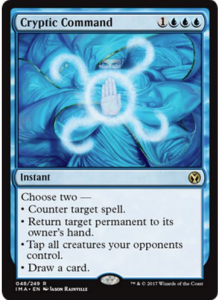Table of Contents
- What is Adventure and How Does it Work?
- What Happens if You Counter an Adventure?
- Do Adventure Cards Count as an Instant or Sorcery?
- Adventure Mechanic Benefits and Drawbacks
- Wrap Up
Magic: the Gathering might just be one of the most complicated card games on the planet, if not the most complicated one. It has tens of thousands of cards and a seemingly infinite number of combinations that players have steadily explored over the course of its decades-long lifespan.
Over the years, new mechanics have been introduced, shelved, and sometimes even revived. One of the newer mechanics is called Adventure.
Some new and old players alike scratched their heads a little over this one. Just in case that includes you, we’ll be explaining how Adventure works here.
What is Adventure and How Does it Work?

Adventure is a mechanic that was introduced with the relatively recent (from the fall of 2019, anyway) Throne of Eldraine set.
See the card pictured above, Murderous Rider, as an example of a card with Adventure. As you can see, the card is split into halves: one with the basic text for the creature, and the other with a half that says Instant – Adventure on it.
Cards with Adventure give you access to two different effects: an instant or sorcery, and a creature. You can cast them as either or.
Pay the cost listed on the Adventure side to cast the instant or sorcery part of the card. The effect described in the Adventure text resolves, unless something prevents it from resolving successfully (such as being countered).
If that seems like a bad thing, don’t worry – you have the option of paying the mana cost at the top of the card to cast the creature from exile.
Basically, it’s like you’re sending the creature on a task when you cast the Adventure part, then calling it back when you cast the creature part.
What Happens if You Counter an Adventure?
So what happens if you cast a card as an Adventure, and one of your opponents counters it? Does it still go into exile?
No. If someone counters your card before its Adventure effect can resolve, then it will not be exiled, meaning you cannot cast it as a creature from exile.
Instead, like other countered instants or sorceries, it will go to your graveyard.
Do Adventure Cards Count as an Instant or Sorcery?
Most of the time, cards with Adventure count as a creature. The only time they count as an instant or sorcery is when you pay the cost on their instant/sorcery half and they go into the stack as such.
For beginners, you can think of the stack as a queue. When you cast a card, it essentially gets in line to resolve its effect, with some cards being able to “cut” in line depending on how fast they are. Instants, for example, go to the front of the line (or the top of the stack) to resolve first.
In other words, your Adventure card is a creature…unless you pay the Adventure cost, casting it as an instant or sorcery, and it waits in the stack to resolve as said instant or sorcery. As soon as it reaches the top of the stack and resolves, it becomes a creature again.
Adventure Mechanic Benefits and Drawbacks
The Good
The best thing about an Adventure card is how inherently versatile it is. Like we mentioned earlier, you’re basically getting two cards in one.
For instance, rather than having to choose between a particular instant and creature, you can have a card that’s both. We know how hard it can be to choose which cards to cut from a deck when you’re making one, so it’s nice when one spot in your lineup can be so multi-functional.
Another benefit to Adventure cards is that, if the Adventure resolves successfully, the creature is exiled and can’t be exiled again while it remains in exile. It sort of functions as protection from your opponents exiling the creature until you’re ready to cast it.
Please note, though, that if your opponent does end up exiling your creature after you’ve cast it, you cannot cast it from exile. Adventure cards can only be cast from exile if said exile resulted from the resolution of their Adventure effect.
The Bad

We’ve spent all this time talking up Adventure, but is it really all it’s cracked up to be?
Truthfully, there is at least one downside to it, depending on which format of the game you’re playing. In some ways, it’s almost twice as hard for an Adventure card to be good, because it’s like two separate cards in one. If one half is rather lackluster, the Adventure card loses the benefit of its versatility, because you’re not likely to use the bad half.
Furthermore, Adventure is generally better in a format like drafting, because, again, there’s so much value in a single card that you can’t necessarily pass it up in a draft. This is not true for other formats.
In constructed formats (formats in which you build a deck in advance), your job is to refine a deck so that it plays as consistently as possible time after time. In such formats, it’s better to have a single card that does one thing really well than a card that could do multiple things mediocrely.
Of course, there have been cards in Magic’s history that were powerful simply because they offered players so many choices. It’s worth noting, though, that these cards provided consistently good choices, and that’s what made them worthwhile. As an example, consider Cryptic Command, pictured above.
Wrap Up
That sums up out brief explanation on the Adventure mechanic. It might seem complex when you first look at an Adventure card, but really, it’s not too hard to grasp once you’ve used it a few times.
What do you think of Adventure cards? Do you like or dislike them? Drop a comment below with your opinion on the mechanic.
